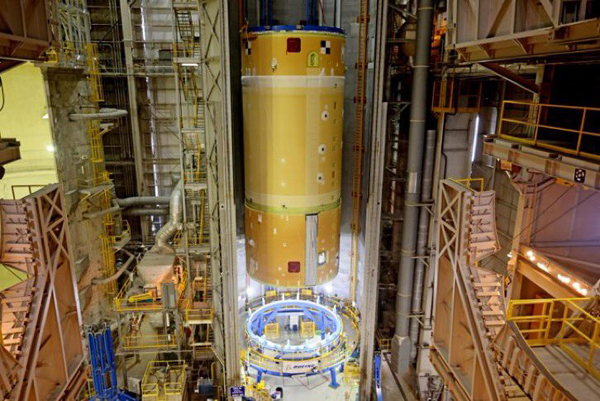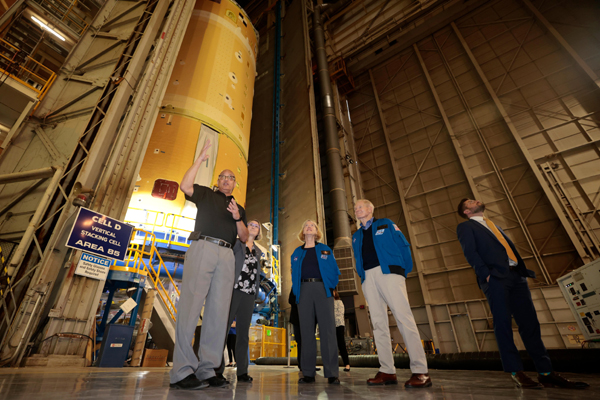 NASA
NASA Selects New Astronaut Recruits to Train for Future Missions (Press Release)
NASA
NASA Selects New Astronaut Recruits to Train for Future Missions (Press Release)
NASA has chosen 10 new astronaut candidates from a field of more than 12,000 applicants to represent the United States and work for humanity’s benefit in space.
NASA Administrator Bill Nelson introduced the members of the 2021 astronaut class, the first new class in four years, during a Monday, Dec. 6 event at Ellington Field near NASA’s Johnson Space Center in Houston.
“Today we welcome 10 new explorers, 10 members of the
Artemis generation, NASA’s 2021 astronaut candidate class,” Nelson said. “Alone, each candidate has ‘the right stuff,’ but together they represent the creed of our country: E pluribus unum – out of many, one.”
The astronaut candidates will report for duty at Johnson in January 2022 to begin two years of training. Astronaut candidate training falls into five major categories: operating and maintaining the International Space Station's complex systems, training for spacewalks, developing complex robotics skills, safely operating a
T-38 training jet, and Russian language skills.
Upon completion, they could be assigned to missions that involve performing research aboard the space station, launching from American soil on spacecraft built by commercial companies, as well as deep space missions to destinations including the Moon on NASA’s
Orion spacecraft and
Space Launch System rocket.
“Each of you has amazing backgrounds,” Pam Melroy, former NASA astronaut and NASA’s deputy administrator, told the candidates. “You bring diversity in so many forms to our astronaut corps and you stepped up to one of the highest and most exciting forms of public service.”
Applicants included U.S. citizens from all 50 states, the District of Columbia, and U.S. territories Puerto Rico, Guam, the Virgin Islands, and Northern Mariana Islands. For the first time ever, NASA required candidates to hold a master’s degree in a STEM field and used an online assessment tool. The women and men selected for the new astronaut class represent the diversity of America and the career paths that can lead to a place in America’s astronaut corps.
The 2021 astronaut candidates are:
Nichole Ayers, 32, major, U.S. Air Force, is a native of Colorado who graduated from the U.S. Air Force Academy in Colorado Springs, Colorado, in 2011 with a bachelor’s degree in mathematics with a minor in Russian. She later earned a master’s degree in computational and applied mathematics from Rice University. Ayers is an experienced combat aviator with more than 200 combat hours and more than 1,150 hours of total flight time in the
T-38 and the
F-22 Raptor fighter jet. One of the few women currently flying the F-22, in 2019 Ayers led the first-ever all-woman formation of the aircraft in combat.
Marcos Berríos, 37, major, U.S. Air Force, grew up in Guaynabo, Puerto Rico. While a reservist in the Air National Guard, Berríos worked as an aerospace engineer for the U.S. Army Aviation Development Directorate at Moffett Federal Airfield in California. He is a test pilot who holds a bachelor’s degree in mechanical engineering from the Massachusetts Institute of Technology and a master’s degree in mechanical engineering as well as a doctorate in aeronautics and astronautics from Stanford University. A distinguished pilot, Berríos has accumulated more than 110 combat missions and 1,300 hours of flight time in more than 21 different aircraft.
Christina Birch, 35, grew up in Gilbert, Arizona, and graduated from the University of Arizona with a bachelor’s degree in mathematics and a bachelor’s degree in biochemistry and molecular biophysics. After earning a doctorate in biological engineering from MIT, she taught bioengineering at the University of California, Riverside, and scientific writing and communication at the California Institute of Technology. She became a decorated track cyclist on the U.S. National Team.
Deniz Burnham, 36, lieutenant, U.S. Navy, calls Wasilla, Alaska, home. A former intern at NASA’s Ames Research Center in Silicon Valley, California, Burnham serves in the U.S. Navy Reserves. She earned a bachelor’s degree in chemical engineering from the University of California, San Diego, and a master’s degree in mechanical engineering from the University of Southern California in Los Angeles. Burnham is an experienced leader in the energy industry, managing onsite drilling projects throughout North America, including in Alaska, Canada, and Texas.
Luke Delaney, 42, major, retired, U.S. Marine Corps, grew up in Debary, Florida. He holds a degree in mechanical engineering from University of North Florida and a master’s degree in aerospace engineering from the Naval Postgraduate School. He is a distinguished naval aviator who participated in exercises throughout the Asia Pacific region and conducted combat missions in support of Operation
Enduring Freedom. As a test pilot, he executed numerous flights evaluating weapon systems integration, and he served as a test pilot instructor. Delaney most recently worked as a research pilot at NASA’s Langley Research Center, in Hampton, Virginia, where he supported airborne science missions. Including his NASA career, Delaney logged more than 3,700 flight hours on 48 models of jet, propeller, and rotary wing aircraft.
Andre Douglas, 35, is a Virginia native. He earned a bachelor’s degree in mechanical engineering from the U.S. Coast Guard Academy, a master’s degree in mechanical engineering from the University of Michigan, a master’s degree in naval architecture and marine engineering from the University of Michigan, a master’s degree in electrical and computer engineering from Johns Hopkins University, and a doctorate in systems engineering from the George Washington University. Douglas served in the U.S. Coast Guard as a naval architect, salvage engineer, damage control assistant, and officer of the deck. He most recently was a senior staff member at the Johns Hopkins University Applied Physics Lab, working on maritime robotics, planetary defense, and space exploration missions for NASA.
Jack Hathaway, 39, commander, U.S. Navy, is a native of Connecticut. He earned bachelors’ degrees in physics and history from the U.S. Naval Academy and completed graduate studies at Cranfield University in England and the U.S. Naval War College. A distinguished naval aviator, Hathaway flew and deployed with Navy’s Strike Fighter Squadron 14 aboard the
USS Nimitz and Strike Fighter Squadron 136 aboard the
USS Truman. He graduated from Empire Test Pilots’ School, supported the Joint Chiefs of Staff at the Pentagon, and was most recently assigned as the prospective executive officer for Strike Fighter Squadron 81. He has more than 2,500 flight hours in 30 types of aircraft, more than 500 carrier arrested landings, and flew 39 combat missions.
Anil Menon, 45, lieutenant colonel, U.S. Air Force, was born and raised in Minneapolis, Minnesota. He was SpaceX’s first flight surgeon, helping to launch the company’s first humans to space during NASA’s SpaceX
Demo-2 mission and building a medical organization to support the human system during future missions. Prior to that, he served NASA as the crew flight surgeon for various expeditions taking astronauts to the International Space Station. Menon is an actively practicing emergency medicine physician with fellowship training in wilderness and aerospace medicine. As a physician, he was a first responder during the 2010 earthquake in Haiti, 2015 earthquake in Nepal, and the 2011
Reno Air Show accident. In the Air Force, Menon supported the 45th Space Wing as a flight surgeon and the 173rd Fighter Wing, where he logged over 100 sorties in the
F-15 fighter jet and transported over 100 patients as part of the critical care air transport team.
Christopher Williams, 38, grew up in Potomac, Maryland. He graduated from Stanford University in 2005 with a bachelor’s degree in physics and a doctorate in physics from MIT in 2012, where his research was in astrophysics. Williams is a board-certified medical physicist, completing his residency training at Harvard Medical School before joining the faculty as a clinical physicist and researcher. He most recently worked as a medical physicist in the Radiation Oncology Department at the Brigham and Women's Hospital and Dana-Farber Cancer Institute in Boston. He was the lead physicist for the Institute’s MRI-guided adaptive radiation therapy program. His research focused on developing image guidance techniques for cancer treatments.
Jessica Wittner, 38, lieutenant commander, U.S. Navy, is a native of California with a distinguished career serving on active duty as a naval aviator and test pilot. She holds a Bachelor of Science in aerospace engineering from the University of Arizona, and a Master of Science in aerospace engineering from the U.S. Naval Postgraduate School. Wittner was commissioned as a naval officer through an enlisted-to-officer program and has served operationally flying
F/A-18 fighter jets with Strike Fighter Squadron 34 in Virginia Beach, Virginia, and Strike Fighter Squadron 151 in Lemoore, California. A graduate of U.S. Naval Test Pilot School, she also worked as a test pilot and project officer with Air Test and Evaluation Squadron 31 in China Lake, California.
With the addition of these 10 members of the 2021 astronaut candidate class, NASA has now selected 360 astronauts since the original
Mercury Seven in 1959.
“We’ve made many giant leaps throughout the last 60 years, fulfilling President Kennedy’s goal of landing a man on the Moon,” said Johnson center Director Vanessa Wyche. “Today we reach further into the stars as we push forward to the Moon once again and on to Mars with NASA’s newest astronaut candidate class.”
Source: NASA.Gov
****



















